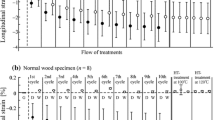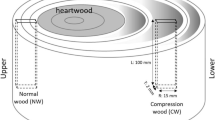Abstract
When a green wood specimen is hygrothermally treated, it often shows dimensional changes in the longitudinal and transversal directions, which is called hygrothermal recovery of wood. Hygrothermal recovery of tension wood is assumed to be behind the unusual contraction of gelatinous layer along the longitudinal axis. This study investigated whether hygrothermal recovery of tension wood was temperature-dependent. Hygrothermal treatment at 80, 100 and 120 °C was given to green Quercus serrata tension wood, and longitudinal and tangential dimensions were recorded. In the longitudinal direction, the trend line obtained after 10 times of 10-min hygrothermal treatments at respective temperatures unraveled that it was comprised of initial recovery and continuum contraction at 100 and 120 °C, but no initial recovery was recognized at 80 °C. In the tangential direction, both the initial and the continuum deformations were expansive, and initial recovery was smaller at 80 °C. The results of multiple comparison test revealed that the parameters characterizing the trend line differed significantly among three temperature sets. Further, the result highlighted the existence of breakage of hygrothermal recovery mechanism at temperature between 80 and 100 °C.










Similar content being viewed by others

References
Abe K, Yamamoto H (2007) The influences of boiling and drying treatment on the behaviors of tension wood with gelatinous layers in Zelkova serrata. J Wood Sci. 53:5–10
Bardet S, Gril J, Kojiro K (2012) Lecture notes in applied and computational mechanics. In: Frémond M, Maceri F (eds) Mechanics, Models and Methods in Civil Engineering, vol 61. Springer, Berlin, pp 157–162
Barnett JR, Bonham VA (2004) Cellulose microfibril angles in the cell wall of wood fibers. Biol Rev 79:461–472
Cave ID (1966) Theory of X-ray measurement of microfibril angle. For Prod J 16:37–42
Chang S, Clair B, Ruelle J, Beaucheˆne J, Di Renzo F, Quignard F, Zhao G, Yamamoto H, Gril J (2009) Mesoporosity as a new parameter for understanding tension stress generation in trees. J Exp Bot 60:3023–3030
Clair B (2012) Evidence that release of internal stress contributes to drying strains of wood. Holzforschung 66:349–353
Clair B, Gril J, Di Renzo F, Yamamoto H, Quignard F (2008) Characterization of gel in the cell wall to elucidate the paradoxical shrinkage of tension wood. Biomacromolecules 9:494–498
Cossalter C, Pye-Smith C (2003) Fast-wood forestry: myths and realities. Center for International Forestry Research, Jakarta
Donaldson LA (2008) Microfibril angle: measurement, variation and relationships—a review. IAWA J 4:345–386
Gril J, Thibaut B (1994) Tree mechanics and wood mechanics: relating hygrothermal recovery of green wood to the maturation process. Ann Sci For 51:329–338
Kojima M, Yamamoto H, Yoshida M, Ojio Y, Okumura K (2009) Maturation property of fast-growing hardwood plantation species: a view of fiber length. For Eco Manage 257(1):15–22
Kojima M, Yamamoto H, Saegusa K, Yamaji FM, Yoshida M, Yamashita S, Nakai T (2012) Anatomical and chemical factors affecting tensile growth stress in Eucalyptus grandis plantations at different latitudes in Brazil. Can J For Res 42:134–140
Kübler H (1959) Studien über Wachstumsspannungen des Holzes III. Längenänderungen bei der Wärmebehandlung frischen Holzes (Studies of growth stresses in trees part 3. Effect of heat treatment on the dimensions of green wood). Holz Roh-Werkst 17:77–86
Okuyama T, Doldan J, Yamamoto H, Ona T (2004) Heart splitting at crosscutting of eucalypt logs. J Wood Sci 50:1–6
Placet V, Passard J, Perre P (2007) Viscoelastic properties of green wood across the grain measured by harmonic tests in the range 0–95 °C: hardwood vs. softwood and normal wood vs. reaction wood. Holzforschung 61:548–557
Placet V, Passard J, Perre P (2008) Viscoelastic properties of wood across the grain measured under water-saturated conditions up to 135 °C: evidence of thermal degradation. J Mater Sci 43:3210–3217
Sasaki Y, Okuyama T (1983) Residual stress and dimensional change on heating green wood. Mokuzai Gakkaishi 29:302–307
Sujan KC, Yamamoto H, Matsuo M, Yoshida M, Naito K, Shirai T (2015) Continuum contraction of tension wood fiber induced by repetitive hygrothermal treatment. Wood Sci Technol 49:1157–1169
Tanaka M, Yamamoto H, Kojima M, Yoshida M, Matsuo M, Abubakar ML, Hongo I, Arizono T (2014) The interrelation between microfibril angle (MFA) and hygrothermal recovery (HTR) in compression wood and normal wood of Sugi and Agathis. Holzforschung 68:823–830
Tanaka M, Yamamoto H, Yoshida M, Matsuo M, Abubakar ML (2015) Retarded recovery of remaining growth stress in Agathis wood specimen caused by drying and subsequent re-swelling treatments. Euro J Wood Prod 73:289–298
Tejada A, Okuyama T, Yamamoto H, Yoshida M, Imai T, Itoh T (1998) Studies on the softening point of wood powder as a basis for understanding the release of residual growth stress in logs. For Prod J 48:84–90
Wahyudi I, Okuyama T, Hadi YS, Yamamoto H, Yoshida M, Watanabe H (1999) Growth stresses and strains in Acacia Mangium. For Prod J 49(2):77–81
Yamamoto H, Okuyama T, Yoshida M (1993) Method of determining the mean microfibril angle of wood over wide range by the improved Cave’s method. Mokuzai Gakkaishi 39:375–381
Yamamoto H, Ruelle J, Arakawa Y, Yoshida M, Clair B, Gril J (2010) Origin of the characteristic hygro-mechanical properties of the gelatinous layer in tension wood from Kunugi oak (Quercus acutissima). Wood Sci Technol 44:149–163
Yokota T, Tarkow H (1962) Changes in dimension on heating green wood. For Prod J 12:43–45
Acknowledgements
The suggestions from Dr. Joseph Gril of LMGC, CNRS, University of Montpellier, France, for polishing this manuscript have highly been appreciated here. Authors are grateful to Dr. Chelsea Robles for making linguistic corrections.
Author information
Authors and Affiliations
Corresponding author
Rights and permissions
About this article
Cite this article
Sujan, K.C., Yamamoto, H., Matsuo, M. et al. Is hygrothermal recovery of tension wood temperature-dependent?. Wood Sci Technol 50, 759–772 (2016). https://doi.org/10.1007/s00226-016-0817-1
Received:
Published:
Issue Date:
DOI: https://doi.org/10.1007/s00226-016-0817-1



